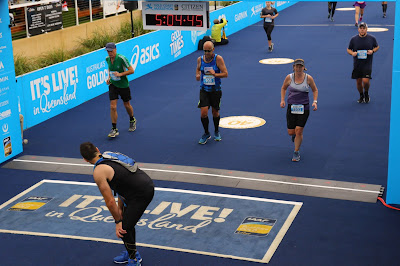We prepare by wearing beanies, scarfs, gloves and jackets.
The grandkids shrink as they are covered by beanies and scarfs. They love being
wrapped under warm clothes. They love
confronting and defeating cold weather.
In front of the stage is an amorphous mass of the backs of
many colorless jackets. Behind the stage are buildings lit by colored lights. I
see arms saluting the people on stage and then realise they are taking photos.
The i-phone salute.
We stand still and the cold infiltrates. On the stage peripatetic
people awaken the crowd with popular songs and rehearsals for the happy song. The
crowd jiggles and moves with the music.
A song containing words such as burning and burn tells me we
are standing near a pile of sticks. A fireman walks around triggering the
appearance of smoke. Flames eventually overpower and win.
My grandkids are lit by light from candles. Their faces
contain excitement and joy mixed with wonder and curiosity. We can’t resist
taking a photo of them.
I speak to a tourist and he says, “You should be used to the
cold.”
I tell him, “I love living in Hobart but occasionally I want
permission to say its bloody cold.”
Everybody is united singing the chosen song. Our ephemeral
voices drift up and away and disappear with the sparks into the darkness. We
are celebrating voice.
Later in the week we have air-conditioning and comfortable
seats as we listen to warm, lush, wonderful harmonies and unaccompanied vocal music.
On stage is Ladysmith
Black Mambazo. An ensemble of nine men. In matching aqua-green tops, black
trousers and white shoes.
When I listen I hear the influence of Christian choirs and
missionaries who introduced so many people to music. Between songs Ladysmith Black Mambazo preach
their message which is love, peace and harmony.
I hear the influence of traditional Zulu chants. As well as
the chants most of the songs are sung in the Zulu language. Going by their actions a lot of the songs
were about animals, birds or the beauty of
rain.
I hear the influence of the mines around Johannesburg. One of their songs “Tough
Times Never Last” tells the story of the mines in South Africa. Poorly paid; a
long way from home with backbreaking physical work. The mines resulted
in male mine workers living in the compounds. Singing and dancing was some sort of respite. In the
singing and the dancing on stage I see very physical and athletic dancing
involving kicking and jumping.
I see the influence of international fame. When they sing
songs such as Amazing
Grace and lines from Old MacDonald they have become an international
group. The world is their home. They
remind us of collaborations with Paul Simon when they sing “Homeless” and “Diamonds
on the Soles of Their Shoes”. Their dancing contained steps and movements from
Chuck Berry, Michael Jackson and Elvis Presley mixed with traditional Zulu
kicks.
I
see the influence of community and family in South Africa. Many of the group
are related. Four are brothers and two original members are still in the group. Most have been in the group for years. Their
goal is to sing together, not out-sing and dominate others. They jostle with
each other and love each other. They
don’t vote the weakest singer off.
Ladysmith
Black Mambazo say their goal is to tour the world with their music and
promote peace, love and harmony.
Steve
Biko said, “It is time for Africa to give something to the world. What we will
give the world is Ubuntu”.
The
word ubuntu translates as humanity.
Ubuntu
is a philosophy where individuals come together, look out for each other and are
communal in outlook. Opposed to materialism
and individualism.
Ubuntu accepts the uniqueness and humanity in everyone.
Unique race or religion. No inferiority or superiority. All are deserving of
love for being unique in their own special way.
This
is what I hear when I hear Ladysmith Black Mambazo. It’s also what I heard at the bonfire. The
festival of voices is full of ubuntu.












